Frank Moss Bennett stands as a distinctive figure in British art history, primarily celebrated for his detailed and evocative paintings depicting historical genre scenes. Active from the late Victorian era through the mid-20th century, Bennett carved a niche for himself by meticulously recreating the atmosphere, costumes, and social interactions of Britain's past, particularly the 17th and 18th centuries. While not an innovator in the modernist sense, his work achieved immense popularity during his lifetime and continues to be appreciated for its narrative charm, historical detail, and nostalgic appeal.
Early Life and Artistic Formation
Frank Moss Bennett was born in Liverpool, England, in 1874. Showing artistic promise from a young age, his formal education began not in art, but at the prestigious Clifton College in Bristol. Following this, his path turned decisively towards an artistic career. He moved to London to pursue training at several notable institutions, indicating a serious commitment to mastering his craft.
His artistic education commenced at the St John's Wood Art School, a well-regarded preparatory school for aspiring artists aiming for the Royal Academy. Subsequently, Bennett enrolled at the Slade School of Fine Art, one of London's leading art institutions, known for its emphasis on draughtsmanship. Here, he studied under influential figures who shaped a generation of British artists. His tutors included Henry Tonks, a formidable draughtsman and teacher, Philip Wilson Steer, a leading figure in British Impressionism, and the celebrated Anglo-American portraitist John Singer Sargent. Studying under such diverse talents exposed Bennett to rigorous academic training alongside more modern sensibilities, although his own style would ultimately lean towards traditional representation.
Bennett completed his formal training at the Royal Academy Schools, further solidifying his academic grounding. During his student years, particularly at the Slade, he formed important connections. He met fellow student Eddie Wells, who would become a lifelong friend, a travel companion on artistic excursions, and eventually his brother-in-law. This period was crucial in honing his technical skills and shaping his artistic direction towards narrative historical painting.
Artistic Style and Preferred Subject Matter
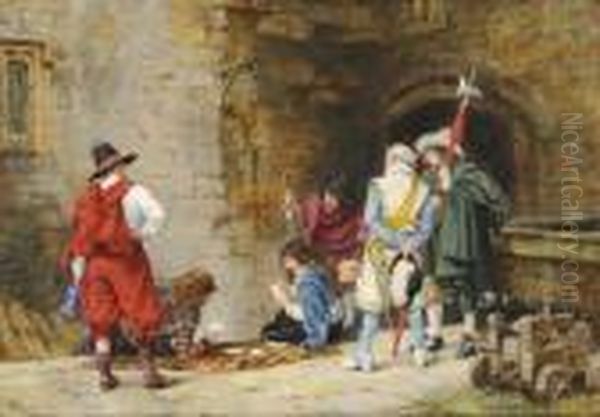
Bennett's artistic identity is firmly rooted in historical genre painting. He possessed a remarkable ability to conjure scenes from Britain's past, focusing predominantly on the 17th and 18th centuries – the eras of the Stuarts and the Georgians. His paintings are character studies as much as historical reconstructions, often depicting gentlemen in moments of leisure, conversation, or quiet contemplation within richly detailed interiors.
His style is characterized by meticulous attention to detail, particularly in costume, furniture, and architectural settings. He aimed for historical accuracy, a quality highly valued by his audience. His brushwork is precise and controlled, serving the narrative and descriptive clarity of the scene rather than drawing attention to itself. The lighting in his paintings is often carefully managed to create atmosphere, typically warm and inviting in interior scenes, highlighting textures of wood, fabric, and metal.
Unlike many of his contemporaries who were experimenting with Impressionism, Post-Impressionism, or Fauvism – artists like Walter Sickert or members of the Bloomsbury Group such as Vanessa Bell and Duncan Grant – Bennett remained steadfastly traditional. His work offered a sense of stability, nostalgia, and narrative coherence that stood in contrast to the fragmentation and abstraction explored by the avant-garde. He was not aiming to challenge artistic conventions but rather to perfect a specific type of historical storytelling through paint.
Key Themes and Representative Works
Bennett's oeuvre revolves around several recurring themes. Tavern scenes are frequent, depicting convivial gatherings, travellers resting, or landlords sharing tales. Scenes set in comfortable manor houses or studies often feature gentlemen engaged in quiet pursuits: reading letters, examining maps, playing chess or cards, enjoying a pipe, or discussing matters of importance. Hunting and equestrian themes also appear, reflecting the pursuits of the landed gentry in the periods he favoured.
While specific titles often varied or were generic descriptions, certain works capture the essence of his output. The Landlord's Story is a quintessential Bennett piece, likely depicting travellers in an inn listening intently to the host. Paintings titled similarly to Cavaliers Playing Cards or A Game of Cards showcase his interest in the Stuart era, often featuring figures in the distinctive attire of the period engaged in leisure. Tea and Scandal suggests a scene of genteel society, perhaps ladies sharing gossip over tea, a common theme in 18th-century settings.
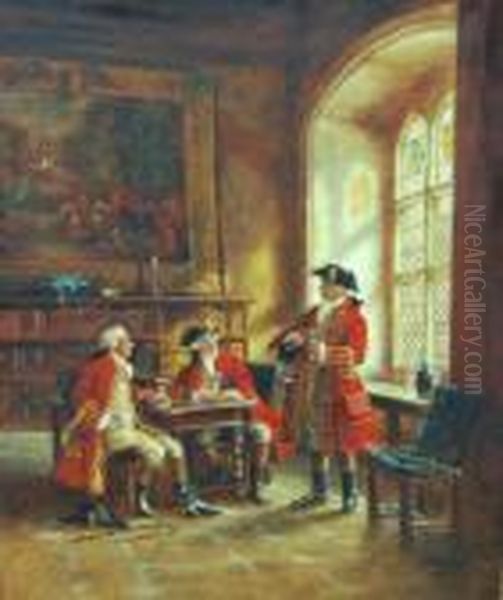
A Stitch in Time (1931) is another documented title, hinting at a domestic scene, possibly involving needlework, emphasizing quiet diligence or perhaps a moment of reflection. Works often carried titles like Discussing the Catch, Signing the Marriage Contract, A Welcome Break, or The Toast, all indicative of narrative moments captured with clarity and detail. He also painted scenes featuring specific historical figures, albeit often in imagined private moments, such as depictions related to the reigns of Queen Elizabeth I, King Charles I, or involving figures like Sir Francis Drake. These works provided viewers with accessible glimpses into the lives of historical personages.
The Pursuit of Authenticity: Costumes and Furnishings
A defining characteristic of Bennett's practice was his dedication to historical accuracy, which extended beyond mere painterly representation. He was an avid collector of historical artefacts, particularly costumes and furniture from the periods he depicted. This was not simply a hobby but an integral part of his working method. He amassed a significant collection of clothing and accessories from the 16th, 17th, and 18th centuries.
This collection served a practical purpose: Bennett used these authentic garments to dress his models, ensuring that the attire rendered in his paintings was accurate down to the cut, fabric, and style. This commitment lent a tangible realism to his scenes, distinguishing his work from less rigorously researched historical paintings. His interest in period detail also extended to furnishings. Sources indicate that Bennett not only collected antique furniture but also designed, restored, and even crafted pieces himself, likely to use as props or to deepen his understanding of the material culture of the past.
His dedication to authenticity was recognized, and parts of his extensive costume collection eventually found homes in museum archives, preserving their historical value. Notable institutions holding items from his collection include the Platt Hall Gallery of Costume in Manchester and the Colonial Williamsburg Foundation in Virginia, USA, testament to the quality and significance of the pieces he gathered. This hands-on approach with historical objects undoubtedly informed the convincing detail found in his paintings.
Commercial Success and Widespread Popularity
Frank Moss Bennett achieved a level of popular success during his lifetime that many artists might envy. While critical acclaim within avant-garde circles might have eluded him, his work resonated strongly with the public and commercial markets. The appeal lay in the nostalgic charm, the storytelling quality, and the easily understandable, detailed realism of his paintings. His scenes offered an escape into romanticized versions of Britain's past.
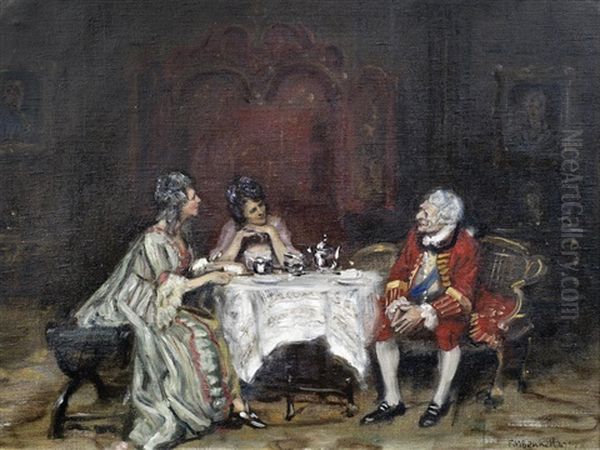
This popularity translated into significant commercial success, primarily through the reproduction of his images. Bennett's paintings were licensed extensively and appeared in numerous formats. They were widely disseminated as prints, making his art accessible to a broad audience beyond original collectors. His work frequently graced the covers of magazines, appeared on calendars, greeting cards, and even jigsaw puzzles and advertising materials.
This widespread reproduction meant that Bennett's images became ubiquitous, part of the visual culture of the early to mid-20th century in Britain. His name became synonymous with these charming historical vignettes. This commercial viability provided him with a steady income and cemented his reputation as a highly popular artist, even if his work operated outside the main currents of modernist art history. His success reflects a public appetite for narrative, historical subjects rendered with skill and nostalgic sentiment.
Exhibitions and Institutional Recognition
Despite his traditional style, Frank Moss Bennett actively participated in the established art world of his time, exhibiting his work regularly at prestigious venues. He frequently submitted paintings to the annual exhibitions at the Royal Academy of Arts in London, a key venue for artists seeking recognition and sales. His consistent presence there indicates acceptance within the academic mainstream.
He also exhibited at other significant institutions, including the Royal Institute of Oil Painters, demonstrating his proficiency in the medium. Given his Liverpool origins, it is highly likely he exhibited at the Walker Art Gallery in Liverpool as well. Some sources suggest he may have also shown work at the Paris Salon, which would indicate an international dimension to his career, though his primary focus remained the British market.
His work was handled by various commercial galleries and dealers, such as the Raymond Gallery mentioned in some accounts. While perhaps not lauded by critics focused on modernism, his regular inclusion in major exhibitions and his representation by dealers underscore his professional standing and the consistent demand for his paintings among collectors and the public. His works are now held in several public collections, including regional galleries in the UK, further solidifying his place, albeit a specific one, within British art history.
Later Life and Enduring Legacy
Frank Moss Bennett remained dedicated to his art throughout his life. He continued to paint prolifically, producing his characteristic historical scenes well into his later years. His passion for his chosen subject matter and his meticulous technique did not wane. He passed away in 1952, reportedly due to complications from a perforated duodenal ulcer, still an active artist.
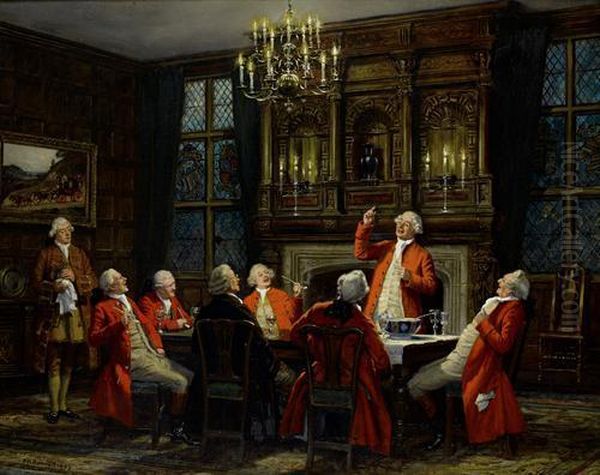
His legacy is multifaceted. He is remembered as a master of historical genre painting, an artist who catered to and perhaps helped shape a popular taste for nostalgic depictions of Britain's past. His commitment to historical accuracy, particularly through his use of authentic costumes and props, sets him apart within this genre. While artists like Edmund Blair Leighton explored similar historical or romantic themes, and painters like William Powell Frith captured detailed scenes of Victorian life, Bennett specialized in recreating the specific ambiance of the 17th and 18th centuries with particular dedication.
Though his style might seem conservative when compared to the radical innovations of his contemporaries or the grand historical statements of earlier academic painters like Sir Lawrence Alma-Tadema or Jean-Léon Gérôme in France, Bennett's work possesses an enduring charm. The continued popularity of his images in print form and the steady market for his original paintings at auction attest to the lasting appeal of his detailed, narrative, and atmospheric glimpses into bygone eras. He remains a significant figure for understanding popular artistic taste in Britain during the first half of the 20th century.
Bennett in the Context of British Art
Placing Frank Moss Bennett within the broader landscape of British art requires acknowledging his traditionalist stance during a period of significant artistic upheaval. While his teachers like Steer and Sargent engaged with or were influenced by Impressionism, Bennett chose a path closer to the detailed narrative style popular in the Victorian era, albeit applied to earlier historical periods. His work can be seen as continuing a tradition of British genre painting, focusing on anecdote and historical setting.
He stands apart from the social realism of artists associated with the Camden Town Group, like Walter Sickert, and the bold colours and forms of the Scottish Colourists. He also differs from the mythological or literary themes explored by late Pre-Raphaelite figures like John William Waterhouse. Bennett's focus was narrower but pursued with great consistency and skill: the re-imagining of everyday life and gentlemanly pursuits in Stuart and Georgian England.
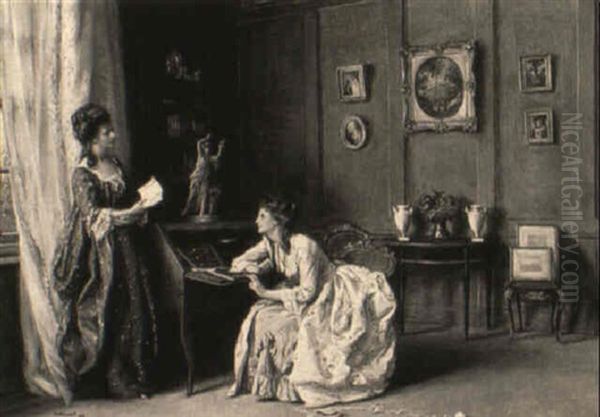
His contemporaries included artists working in various styles. Augustus John, another Slade alumnus, gained fame for his expressive portraits and bohemian subjects. Arthur Hacker worked in historical and portrait genres, sometimes with a more symbolic leaning. Compared to these figures, Bennett's output was remarkably consistent in theme and style. His meticulousness might recall earlier painters known for detail, perhaps even echoing, in its pursuit of historical veracity, the intense detail found in the work of Dutch Golden Age painters or later French academic painters like Ernest Meissonier, though Bennett's subject matter was distinctly British. His unique contribution lies in the sheer volume and popularity of his specific brand of historical genre scenes, which captured the public imagination for decades.